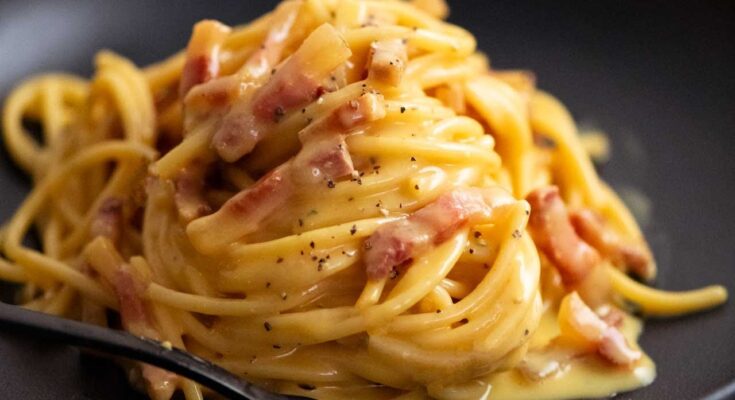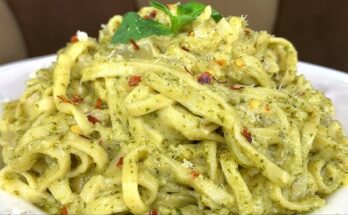Authentic Carbonara Italian Recipe: Carbonara isn’t just a pasta dish—it’s an Italian treasure, a creamy, savory comfort food that’s stood the test of time. What makes it so special? For starters, it’s made with just a handful of ingredients, yet delivers a deep, complex flavor. It’s also one of those rare dishes that doesn’t need cream to be creamy—the sauce is made silky smooth using just eggs, cheese, and the rendered fat from guanciale. That’s culinary alchemy at its finest. Carbonara brings together richness, saltiness, and that unmistakable kick from black pepper, making every bite a delightful experience. And the best part? You can whip it up in under 30 minutes, making it perfect for both quick weeknight meals and impressive dinner parties.
Origins of Carbonara – A Roman Classic
Though its exact origin is debated, most food historians agree that carbonara hails from Rome. It’s deeply rooted in the traditions of Roman cuisine, which favors simplicity and powerful, well-balanced flavors. Some say it was created during World War II when American soldiers brought bacon and eggs to Italy, while others claim it’s older than that. Regardless, it has become a symbol of Italian culinary pride. Authentic Roman carbonara uses guanciale (not bacon or pancetta), Pecorino Romano, fresh eggs, and a lot of black pepper. No garlic, no onion, and definitely no cream! Its beauty lies in its authenticity and the respect it shows for tradition.
Essential Ingredients
Choosing the Right Pasta
Spaghetti is the traditional choice, but other long pastas like rigatoni, bucatini, or fettuccine can also work beautifully. What you’re really after is a pasta that holds onto the sauce well. Spaghetti’s smooth surface and flexibility make it a favorite, ensuring a consistent coating of the egg-cheese mixture in every strand. If you’re aiming for full authenticity, go with bronze-cut pasta. It has a rougher surface that grabs the sauce better, elevating both texture and taste.
The Magic of Guanciale
Guanciale is the soul of carbonara. This cured pork cheek is rich, fatty, and deeply flavorful. When fried gently, it releases luscious fat that becomes the base of your sauce. Unlike bacon, guanciale isn’t smoky—it’s more subtly spiced and intensely porky. That’s key. You’ll want to cut it into thick lardons or cubes, not thin strips, so that it crisps up while retaining a chewy center. Can’t find guanciale? Pancetta is the closest substitute, but steer clear of bacon if you want to keep it authentic.
Pecorino Romano – A Sharp Cheese Staple
Pecorino Romano brings a salty, tangy punch to the sauce that balances out the richness of the eggs and pork fat. This sheep’s milk cheese is crumbly, dry, and full of personality. Don’t substitute it with Parmesan unless you absolutely have to—they’re both hard cheeses, but Pecorino has a sharper and saltier flavor profile. Always grate it fresh for the best melt and taste. Pre-shredded cheese simply doesn’t do justice here.
Eggs – The Creamy Foundation
Eggs are the backbone of that luscious carbonara sauce. Traditional recipes use whole eggs or a mix of whole eggs and yolks. Yolks give the sauce extra richness, making it velvety and golden. A good rule of thumb? Use 1 whole egg per serving, plus an extra yolk or two for added depth. Make sure your eggs are fresh and at room temperature—they’ll mix better and won’t scramble when combined with the pasta.
Black Pepper – The Underrated Hero
Never underestimate the role of black pepper in carbonara. It’s not just seasoning—it’s a defining flavor. Freshly cracked black pepper adds a spicy kick that cuts through the fat and balances the creamy sauce. Use a generous amount, and grind it coarsely to give the dish some texture and aroma. It’s this peppery bite that gives carbonara its signature zing and namesake—“carbonaro” means charcoal burner, a nod to the dish’s pepper-flecked appearance.
Preparation Tips Before Cooking
Room Temperature Eggs
This tip is crucial. Cold eggs won’t emulsify as smoothly when mixed with the hot pasta, and the temperature shock could cause them to scramble. Take them out of the fridge at least 30 minutes before you cook. Room-temperature eggs mix more easily with cheese and pasta, creating a creamy, even sauce instead of clumps. It’s a small detail that makes a huge difference.
Grating Cheese Fresh
Forget the pre-shredded stuff. Freshly grated Pecorino Romano has a much stronger flavor and melts far better. Those bags of shredded cheese often contain anti-caking agents that mess with the texture of your sauce. Use a fine grater or microplane to create a light, fluffy cheese pile that blends seamlessly into the eggs. The finer the cheese, the silkier the sauce.
Slicing Guanciale Properly
Cut your guanciale into thick, even pieces—about ½-inch lardons. Too thin, and they’ll burn before they can render enough fat. Too thick, and they might stay chewy instead of crisping up. Fry them low and slow, letting the fat melt and the edges crisp without overcooking. Once done, remove them from the pan but keep the fat—that’s liquid gold and the base of your sauce.
Step-by-Step Instructions
Step 1 – Boil the Pasta
Bring a large pot of water to a boil and salt it generously—it should taste like the sea. Add your spaghetti and cook until just shy of al dente, usually a minute less than the package suggests. You want the pasta slightly firm, as it’ll continue to cook when mixed with the sauce. Don’t forget to reserve about a cup of the starchy pasta water before draining—it’s essential for creating the perfect sauce texture.
Step 2 – Cook the Guanciale
While the pasta’s cooking, heat a large skillet over medium-low heat. Add the guanciale and cook until it turns golden and crispy, about 5-7 minutes. Stir occasionally so it renders evenly. Once done, remove the guanciale with a slotted spoon and set aside. Keep the rendered fat in the pan—you’ll use it to bind the sauce to the pasta. The aroma at this stage is mouthwatering and a sign you’re on the right track.
Step 3 – Whisk the Egg Mixture
While your pasta cooks and guanciale sizzles, it’s time to prep the creamy component of carbonara—the egg and cheese mixture. In a large mixing bowl, whisk together the room-temperature eggs (or a combo of eggs and yolks for extra richness) and the finely grated Pecorino Romano. The goal here is to form a thick, paste-like consistency. Add a generous amount of freshly cracked black pepper—this isn’t just a dash; think of it more like a seasoning layer. Keep whisking until everything is well combined and smooth. This mixture will become the base of your silky sauce, relying entirely on the heat of the pasta to transform into something magical—no stove heat required. Pro tip? Temper the eggs by adding a tablespoon of hot pasta water slowly while whisking to prevent scrambling later.
Step 4 – Combine Everything Without Scrambling
This is the most crucial part of making carbonara, and it separates the amateurs from the pros. Drain the pasta (remembering to save some of that starchy water), and while it’s still piping hot, quickly toss it into the bowl with the egg-cheese mixture. Stir vigorously and continuously. The heat from the pasta will gently cook the eggs, melting the cheese and emulsifying everything into a creamy, rich sauce. If the mixture seems too thick or sticky, add a splash of the reserved pasta water—just enough to get the consistency you want. Add in the crispy guanciale and stir again. The pasta should be coated in a glossy, velvety sauce that clings beautifully to each strand, with little bits of guanciale peeking through and black pepper speckled throughout.
Pro Tips for Perfect Carbonara
Avoiding Common Mistakes
Let’s bust a few carbonara myths. First off: no cream. If you’re using heavy cream, it’s no longer carbonara—it’s pasta with a cream sauce. True carbonara gets all its richness from eggs, cheese, and guanciale. Second, never add the eggs directly to a hot pan with heat still on—this will scramble them instantly. Always mix the eggs off the heat. And please, no garlic or onions—they have no place in authentic carbonara. Another rookie mistake? Using bacon instead of guanciale. While bacon might seem like a close cousin, it’s usually smoked and leaner, which changes the flavor and texture entirely.
How to Achieve the Perfect Sauce Texture
Want that sauce to cling like a dream? The secret is all in the pasta water and timing. Make sure the pasta is hot enough to gently cook the egg mixture but not so hot that it scrambles. Mixing vigorously as soon as the pasta hits the egg bowl helps emulsify the sauce. And that reserved starchy water? It’s liquid gold. Add it in little by little as you stir—this helps bind everything together and creates that silky, restaurant-quality sheen. The result? A luscious, creamy, peppery sauce with a luxurious mouthfeel, achieved without a drop of dairy fat beyond cheese.
FAQs about Authentic Carbonara Italian Recipe
1. Can I use bacon instead of guanciale?
Yes, but keep in mind it won’t taste exactly the same. Bacon is smoked and leaner, which alters the flavor and texture. Guanciale is more traditional and brings that authentic Roman touch.
2. Why did my sauce scramble?
This usually happens when the eggs are added to pasta that’s too hot or stirred too slowly. Always take the pan off the heat before combining and stir vigorously to emulsify the sauce.
3. Can I use Parmesan instead of Pecorino Romano?
You can, especially if you prefer a milder flavor. But for the most authentic carbonara experience, Pecorino Romano is the traditional cheese of choice.
4. Is it okay to reheat carbonara?
It’s best eaten fresh, but if you must reheat it, do so gently over low heat with a splash of pasta water to loosen the sauce. Avoid microwaving, as it will likely scramble the eggs.
5. What’s the ideal pasta shape for carbonara?
Spaghetti is the classic choice, but bucatini, rigatoni, or even linguine work well. Stick with long, firm pasta shapes that can hold the sauce nicely.
Conclusion
There’s something deeply satisfying about making a dish as timeless and pure as authentic Roman carbonara. It’s about respecting the ingredients, honoring tradition, and finding joy in simplicity. No gimmicks. No shortcuts. Just a perfect union of pasta, eggs, cheese, guanciale, and pepper—five humble ingredients, infinite flavor. Whether you’re serving it for a romantic dinner, family meal, or late-night craving, mastering carbonara is like unlocking a delicious piece of Italy in your own kitchen. Now that you’ve got the method down, you’re well on your way to making the best carbonara of your life.



